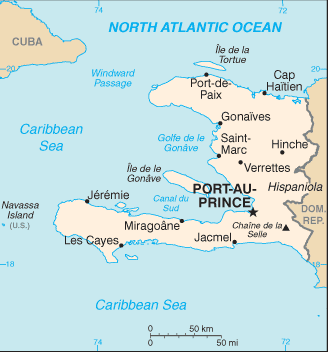United Nations peacekeepers might not be the sole source of Haiti’s cholera epidemic, according to a university research group. In January 2010, a powerful earthquake devastated the island nation, killing thousands and forcing hundreds of thousands from their homes. In October of that year, an outbreak of cholera swept across much of Haiti, one case even appeared as far away as Miami. In March 2011, around 250,000 cases of cholera had been report, resulting in just under 5,000 deaths. By the end of May the death toll had risen to 7,188 (PDF).
The origin of the epidemic has been the source of much contention. In November, a multi-day and deadly riot erupted after rumors spread that the disease was triggered by Nepalese UN peacekeepers. This theory gained significant traction after the release of a research article in the CDC’s Emerging Infectious Diseases journal claiming that “there was an exact correlation in time and places between the arrival of a Nepalese battalion fro an area experiencing a cholera outbreak and the appearance of the first cases in a few days after.” Furthermore, the CDC also found that the strain observed in Haitian cholera patients closely resembled a strain from South Asia, suggesting it was imported from that region. It is now almost universally believed that the peacekeepers the source of the outbreak.
However, that might not be the whole story, at least according to new work coming out of a group of University of Maryland researchers and reported by NPR. The leader of the team, Rita Colwell found evidence that not one, but two strains of cholera exist in Haitian cholera patients. Half of the patients sampled had the South Asian strain previously reported, however slightly less than a quarter of the patients had a domestic strain of cholera previously not known to cause epidemics:
What can this mean? It’s not clear, but the leader of the team, Rita Colwell, thinks cholera germs have been lurking undetected in the Haitian environment for a long time.
“This suggests that it’s very likely that local (Haitian) strains are involved,” Colwell told Shots. “Because no one has tested for pathogenic cholera strains in that country before, we have no evidence that it wasn’t there already.”
I asked Colwell if she thinks one strain was introduced by the Nepalese soldiers and the other was native to Haiti, or at least predated the current epidemic.
“The introduction (from Nepal) can’t be ruled out but it can’t be proven either,” she replied. “I think the evidence is at best circumstantial, and it is not sufficient to account for the entire epidemic.”
Regardless of what triggered the cholera epidemic, the outbreak has led to large-scale efforts to both vaccinate thousands of Haitians to the disease and improve hygiene and water sanitation in the country. However, even in ideal conditions, these anti-cholera efforts will take years to complete and until then the only thing Haitians can know for certain that there will be more cases of cholera in the country, and more deaths.
